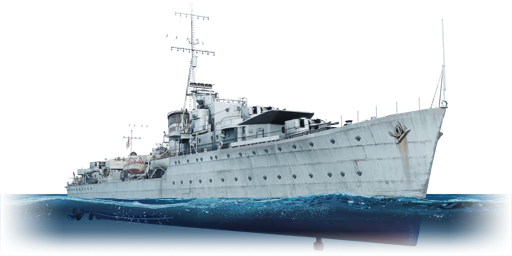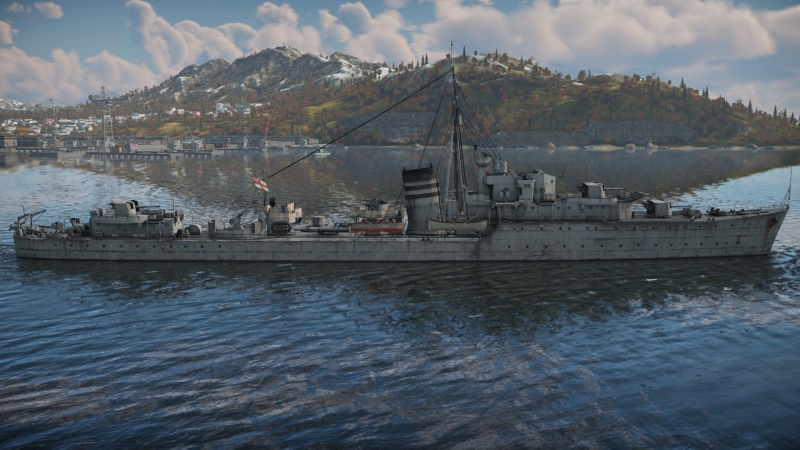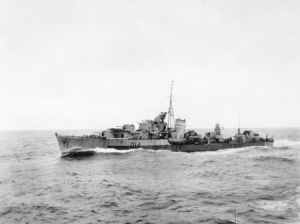Difference between revisions of "HMAS Nepal"
(Updated format) |
Bonisducks (talk | contribs) (→History) (Tag: Visual edit) |
||
| Line 55: | Line 55: | ||
'''Pros:''' | '''Pros:''' | ||
| + | |||
* | * | ||
'''Cons:''' | '''Cons:''' | ||
| + | |||
* | * | ||
== History == | == History == | ||
| − | <!-- ''Describe the history of the creation and combat usage of the ship in more detail than in the introduction. If the historical reference turns out to be too long, take it to a separate article, taking a link to the article about the ship and adding a block "/History" (example: <nowiki>https://wiki.warthunder.com/(Ship-name)/History</nowiki>) and add a link to it here using the <code>main</code> template. Be sure to reference text and sources by using <code><nowiki><ref></ref></nowiki></code>, as well as adding them at the end of the article with <code><nowiki><references /></nowiki></code>. This section may also include the ship's dev blog entry (if applicable) and the in-game encyclopedia description (under <code><nowiki>=== In-game description ===</nowiki></code>, also if applicable).'' --> | + | <!-- ''Describe the history of the creation and combat usage of the ship in more detail than in the introduction. If the historical reference turns out to be too long, take it to a separate article, taking a link to the article about the ship and adding a block "/History" (example: <nowiki>https://wiki.warthunder.com/(Ship-name)/History</nowiki>) and add a link to it here using the <code>main</code> template. Be sure to reference text and sources by using <code><nowiki><ref></ref></nowiki></code>, as well as adding them at the end of the article with <code><nowiki><references /></nowiki></code>. This section may also include the ship's dev blog entry (if applicable) and the in-game encyclopedia description (under <code><nowiki>=== In-game description ===</nowiki></code>, also if applicable).'' -->[[File:HMAS Nepal AWM-301077.jpg|thumb|HMAS Nepal (ex-Norseman), date unknown.]] |
| + | The N Class, HMAS Nepal was a N-class destroyer built for the Royal Australian Navy. Initially launched as HMS Norseman, the ship was severely damaged by air raids during construction and renamed HMAS Nepal, destined to serve with the Australian Navy. HMAS Nepal served extensively during the Second World War, primarily in the Indian and Pacific theatres of war. Following the cessation of hostilities, she was returned to the British, who eventually scrapped her by 1956. | ||
| + | |||
| + | === Design and construction === | ||
| + | The N class of destroyers were the final class in the trio of classes known as the J, K, and N classes. They were the heaviest-armed out of the three classes and carried a substantial main armament. As with the previous J and K classes, the N class had a reduced torpedo armament in favour of carrying additional anti-aircraft guns. The HMAS Nepal was initially ordered and built as HMS Norseman, but in December of 1941, an air raid caused serious damage to the unfinished ship. As a result, the decision was made to complete her as HMAS Nepal, in honour of the Nepalese contribution to the war effort. | ||
| + | |||
| + | HMAS Nepal displaced 1760 tons standard and had a crew of 226 officers and men. The ship’s main armament consisted of six 4.7 inch (119 mm) QF Mk XII dual-purpose main guns in three dual turrets, two fore and one aft. The ship’s anti-aircraft armament consisted of a single 4 inch QF Mk V gun, a four-barreled 40 mm Pom Pom gun, and numerous smaller anti-aircraft guns. Powered by steam turbines producing 40 000 shaft horsepower, the ship was able to reach a max speed of 36 knots (67 km/h). | ||
| + | |||
| + | === Operational history === | ||
| + | After her commissioning as HMAS Nepal, the ship was loaned to the Australian navy, while the United Kingdom retained ownership of the ship itself. She was immediately assigned to the Home Fleet, and was used in the filming of the war film In Which We Serve. In July of 1942, the ship was transferred to the British Eastern Fleet, which it would serve with for most of the duration of the Second World War. The ship participated in the later parts of the Madagascar campaign, and participated in convoy escort / patrol duties in the Eastern theatre. In March of 1943, she sailed to Australia for a refit. | ||
| + | |||
| + | Following the completion of the refit, Nepal returned to the Eastern theatre and provided cover during Operation Cockpit and Operation Transom. During this time, she frequently escorted aircraft carriers, and also provided fire support to units on land. In March of 1945, she was transferred to the British Pacific Fleet, and remained there until the end of the war without seeing much action. She was thereafter returned to the British, who reduced her into reserve. She was subsequently used as a training and trials ship, before being scrapped by 1956. HMAS Nepal earned four battle stars for her WWII service. | ||
| + | |||
| + | === [[wt:en/news/5814-fleet-development-hmas-nepal-g25-air-raid-survivor-en|Devblog]] === | ||
HMAS Nepal was laid down in Great Britain in September of 1939, initially under the name of "Norseman". As one of the last ships of the N-class destroyer type, she was launched in December 1941, but was soon severely damaged while still in the shipyard during a German air raid. | HMAS Nepal was laid down in Great Britain in September of 1939, initially under the name of "Norseman". As one of the last ships of the N-class destroyer type, she was launched in December 1941, but was soon severely damaged while still in the shipyard during a German air raid. | ||
| Line 73: | Line 88: | ||
In the postwar years, HMS Nepal underwent repairs and modifications, briefly serving as a minesweeper and training ship. In the early 1950s, HMS Nepal was part of the reserve and awaiting some proposed upgrades. However, those upgrades were eventually cancelled and the decision was made to scrap the ship. January 1956 marked the end of HMS Nepal's 14-year service life as she was sold off for scraps to the British Iron & Steel Corporation. | In the postwar years, HMS Nepal underwent repairs and modifications, briefly serving as a minesweeper and training ship. In the early 1950s, HMS Nepal was part of the reserve and awaiting some proposed upgrades. However, those upgrades were eventually cancelled and the decision was made to scrap the ship. January 1956 marked the end of HMS Nepal's 14-year service life as she was sold off for scraps to the British Iron & Steel Corporation. | ||
| − | |||
| − | |||
== Media == | == Media == | ||
| Line 81: | Line 94: | ||
== See also == | == See also == | ||
''Links to articles on the War Thunder Wiki that you think will be useful for the reader, for example:'' | ''Links to articles on the War Thunder Wiki that you think will be useful for the reader, for example:'' | ||
| + | |||
* ''reference to the series of the ship;'' | * ''reference to the series of the ship;'' | ||
* ''links to approximate analogues of other nations and research trees.'' | * ''links to approximate analogues of other nations and research trees.'' | ||
| Line 92: | Line 106: | ||
* [[wt:en/news/5814-fleet-development-hmas-nepal-g25-air-raid-survivor-en|[Devblog] HMAS Nepal (G25): Air Raid Survivor]] | * [[wt:en/news/5814-fleet-development-hmas-nepal-g25-air-raid-survivor-en|[Devblog] HMAS Nepal (G25): Air Raid Survivor]] | ||
| + | === References === | ||
| + | |||
| + | * Naval History Society of Australia. (2017, March 29). HMAS Nepal Archives. Retrieved January 19, 2021, from <nowiki>https://www.navyhistory.org.au/ranships/hmas-nepal/</nowiki> | ||
{{Britain destroyers}} | {{Britain destroyers}} | ||
Revision as of 20:15, 20 January 2021
Contents
Description
The N-class, HMAS Nepal (G25), 1942 is a rank II British destroyer with a battle rating of 4.3 (AB/RB/SB). It was introduced in Update 1.83 "Masters of the Sea" as part of the British fleet closed beta test.
General info
Survivability and armour
Talk about the vehicle's armour. Note the most well-defended and most vulnerable zones, e.g. the ammo magazine. Evaluate the composition of components and assemblies responsible for movement and manoeuvrability. Evaluate the survivability of the primary and secondary armaments separately. Don't forget to mention the size of the crew, which plays an important role in fleet mechanics. Save tips on preserving survivability for the "Usage in battles" section. If necessary, use a graphical template to show the most well-protected or most vulnerable points in the armour.
Mobility
Write about the ship's mobility. Evaluate its power and manoeuvrability, rudder rerouting speed, stopping speed at full tilt, with its maximum forward and reverse speed.
| Mobility Characteristics | |||
|---|---|---|---|
| Game Mode | Upgrade Status | Maximum Speed (km/h) | |
| Forward | Reverse | ||
| AB | |||
| Upgraded | 85 | 31 | |
| RB/SB | |||
| Upgraded | 69 | 25 | |
Modifications and economy
Armament
Primary armament
Provide information about the characteristics of the primary armament. Evaluate their efficacy in battle based on their reload speed, ballistics and the capacity of their shells. Add a link to the main article about the weapon: {{main|Weapon name (calibre)}}. Broadly describe the ammunition available for the primary armament, and provide recommendations on how to use it and which ammunition to choose.
Secondary armament
Some ships are fitted with weapons of various calibres. Secondary armaments are defined as weapons chosen with the control Select secondary weapon. Evaluate the secondary armaments and give advice on how to use them. Describe the ammunition available for the secondary armament. Provide recommendations on how to use them and which ammunition to choose. Remember that any anti-air armament, even heavy calibre weapons, belong in the next section. If there is no secondary armament, remove this section.
Anti-aircraft armament
An important part of the ship's armament responsible for air defence. Anti-aircraft armament is defined by the weapon chosen with the control Select anti-aircraft weapons. Talk about the ship's anti-air cannons and machine guns, the number of guns and their positions, their effective range, and about their overall effectiveness – including against surface targets. If there are no anti-aircraft armaments, remove this section.
Additional armament
Describe the available additional armaments of the ship: depth charges, mines, torpedoes. Talk about their positions, available ammunition and launch features such as dead zones of torpedoes. If there is no additional armament, remove this section.
Usage in battles
Describe the technique of using this ship, the characteristics of her use in a team and tips on strategy. Abstain from writing an entire guide – don't try to provide a single point of view, but give the reader food for thought. Talk about the most dangerous opponents for this vehicle and provide recommendations on fighting them. If necessary, note the specifics of playing with this vehicle in various modes (AB, RB, SB).
Pros and cons
Summarise and briefly evaluate the vehicle in terms of its characteristics and combat effectiveness. Mark its pros and cons in the bulleted list. Try not to use more than 6 points for each of the characteristics. Avoid using categorical definitions such as "bad", "good" and the like - use substitutions with softer forms such as "inadequate" and "effective".
Pros:
Cons:
History
The N Class, HMAS Nepal was a N-class destroyer built for the Royal Australian Navy. Initially launched as HMS Norseman, the ship was severely damaged by air raids during construction and renamed HMAS Nepal, destined to serve with the Australian Navy. HMAS Nepal served extensively during the Second World War, primarily in the Indian and Pacific theatres of war. Following the cessation of hostilities, she was returned to the British, who eventually scrapped her by 1956.
Design and construction
The N class of destroyers were the final class in the trio of classes known as the J, K, and N classes. They were the heaviest-armed out of the three classes and carried a substantial main armament. As with the previous J and K classes, the N class had a reduced torpedo armament in favour of carrying additional anti-aircraft guns. The HMAS Nepal was initially ordered and built as HMS Norseman, but in December of 1941, an air raid caused serious damage to the unfinished ship. As a result, the decision was made to complete her as HMAS Nepal, in honour of the Nepalese contribution to the war effort.
HMAS Nepal displaced 1760 tons standard and had a crew of 226 officers and men. The ship’s main armament consisted of six 4.7 inch (119 mm) QF Mk XII dual-purpose main guns in three dual turrets, two fore and one aft. The ship’s anti-aircraft armament consisted of a single 4 inch QF Mk V gun, a four-barreled 40 mm Pom Pom gun, and numerous smaller anti-aircraft guns. Powered by steam turbines producing 40 000 shaft horsepower, the ship was able to reach a max speed of 36 knots (67 km/h).
Operational history
After her commissioning as HMAS Nepal, the ship was loaned to the Australian navy, while the United Kingdom retained ownership of the ship itself. She was immediately assigned to the Home Fleet, and was used in the filming of the war film In Which We Serve. In July of 1942, the ship was transferred to the British Eastern Fleet, which it would serve with for most of the duration of the Second World War. The ship participated in the later parts of the Madagascar campaign, and participated in convoy escort / patrol duties in the Eastern theatre. In March of 1943, she sailed to Australia for a refit.
Following the completion of the refit, Nepal returned to the Eastern theatre and provided cover during Operation Cockpit and Operation Transom. During this time, she frequently escorted aircraft carriers, and also provided fire support to units on land. In March of 1945, she was transferred to the British Pacific Fleet, and remained there until the end of the war without seeing much action. She was thereafter returned to the British, who reduced her into reserve. She was subsequently used as a training and trials ship, before being scrapped by 1956. HMAS Nepal earned four battle stars for her WWII service.
Devblog
HMAS Nepal was laid down in Great Britain in September of 1939, initially under the name of "Norseman". As one of the last ships of the N-class destroyer type, she was launched in December 1941, but was soon severely damaged while still in the shipyard during a German air raid.
Despite the severe damage, the ship was repaired and renamed to Nepal, in recognition of Nepal's contribution to the British war effort. After the repairs were completed, the ship was formally commissioned into service with the Royal Australian Navy in May 1942, although still remaining the property of the Royal Navy.
In July 1942, HMAS Nepal was assigned to the British Eastern Fleet and shortly afterwards set out for Kenya. In September, HMAS Nepal was involved in the Madagascar campaign. Before heading to Australia for refits in spring 1943, the ship served as a convoy escort and performed anti-submarine patrols.
After her two-month long refit, HMAS Nepal resumed operations in June 1943, taking part in some major operations in 1944 as a carrier escort. The ship underwent another refit in August 1944, before embarking on some of her final operations.
HMAS Nepal remained active in the Pacific theatre until the end of WW2, until being decommissioned from RNA service in October 1945. The ship was commissioned once more into the Royal Navy shortly after, being ordered to return to Britain.
In the postwar years, HMS Nepal underwent repairs and modifications, briefly serving as a minesweeper and training ship. In the early 1950s, HMS Nepal was part of the reserve and awaiting some proposed upgrades. However, those upgrades were eventually cancelled and the decision was made to scrap the ship. January 1956 marked the end of HMS Nepal's 14-year service life as she was sold off for scraps to the British Iron & Steel Corporation.
Media
Excellent additions to the article would be video guides, screenshots from the game, and photos.
See also
Links to articles on the War Thunder Wiki that you think will be useful for the reader, for example:
- reference to the series of the ship;
- links to approximate analogues of other nations and research trees.
External links
References
- Naval History Society of Australia. (2017, March 29). HMAS Nepal Archives. Retrieved January 19, 2021, from https://www.navyhistory.org.au/ranships/hmas-nepal/
| Britain destroyers | |
|---|---|
| Town-class | HMS Churchill · HMS Montgomery |
| V-class | HMS Valhalla · HMS Vega · HMS Verdun |
| G-class | HMS Grafton · ORP Garland |
| Hunt-class | HMS Calpe · HMS Brissenden |
| Tribal-class | HMCS Haida · HMS Eskimo · HMS Mohawk |
| J-class | HMS Jervis |
| K-class | HMS Kelvin |
| N-class | HMAS Nepal |
| Battle-class | HMS Armada · HMS Cadiz · HMAS Tobruk |
| Daring-class | HMS Daring · HMS Diamond · HMS Diana |






